#Chadar Trek
Text
Frozen River Trek
The Frozen River Trek, also known as the Chadar Trek, is a challenging walk in the Ladakh area with a breathtaking backdrop of natural colors. The difficult mountain path meanders through valleys, past frozen waterfalls, and along the blocked river of ice under the clear winter sky. Due to the rugged terrain and the possibility of extremely rare and severe weather conditions, such as minus 10 degrees, this is one of the most difficult treks in the Indian Himalayas.
Over eight icy days, the 90-kilometer Frozen River Trek is one of the most popular winter walks. In the Indian Himalayas, it's also one of the longest trekking paths. Like a walk in heaven, the Chadar Trek snatches many hikers' fantasies and becomes a part of their memoirs. The journey starts in Ladakh and concludes in the Zanskar Valley's snow-covered towns.
For More Information Please Visit our Website: Trip Counselors.

#chadar trek#chadar#chadar trekking#chadar trek cost#chadar trek price#chadar lake trek#chadar frozen river trek#chadar the frozen river trek#chadar lake#frozen river trek#night chadar trek#chadar trek package#chadar trek the himalayas#trip counselors#trip planner#tour planner#travel plan#plan my trip#vacation planner#easy trip planner#itinerary planning#solo trip#travel with friends#family tour#tour and travel
0 notes
Text
Chadar Trek: An Adventure of a Lifetime on the Frozen Zanskar River
Ladakh, often referred to as the "Land of High Passes," is a region in India that's known for its breathtaking landscapes, rich culture, and thrilling adventures. If you're someone who seeks adrenaline-pumping experiences and a deep connection with nature, Ladakh is the place to be. In this blog, we're going to delve into the exhilarating world of the Chadar Trek—an adventure of a lifetime on the frozen Zanskar River. But before we embark on this frozen journey, let's take a moment to explore two other gems of Ladakh: Pangong Lake and the monasteries of Ladakh that dot its terrain.
Chadar Trek: A Frozen Odyssey
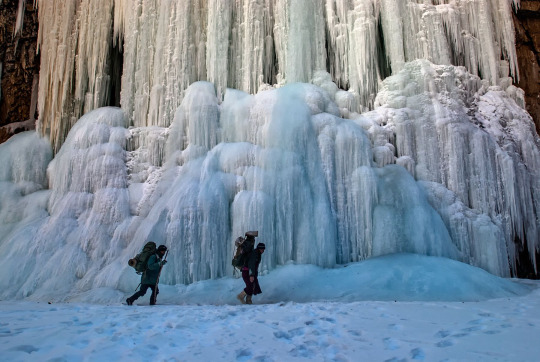
The Chadar Trek, often referred to as the 'Frozen River Trek,' is a winter expedition that takes trekkers through the heart of Ladakh's most remote and surreal landscapes. This trek is unique in its own right because it involves walking on a frozen river, the Zanskar River, which transforms into a thick sheet of ice during the harsh winter months. The name 'Chadar' translates to 'sheet' or 'blanket,' signifying the frozen blanket that covers the river's surface.
The Frozen Zanskar River: A Treacherous Beauty
The Chadar Trek, spanning around 105 kilometers, is not for the faint-hearted. It's a challenging adventure that requires physical endurance, mental strength, and the ability to adapt to extreme cold conditions. The temperatures can plummet to as low as minus 30 degrees Celsius, making it one of the coldest treks in the world. But those who dare to undertake this journey are rewarded with a surreal and almost otherworldly experience.
Traversing the Chadar: The Adventure Begins
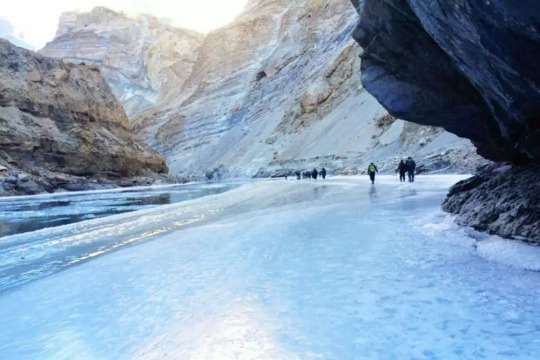
The trek typically starts from the village of Chilling, and trekkers traverse the frozen river to reach the village of Nerak. Along the way, you'll encounter stunning frozen waterfalls, towering icy cliffs, and the mesmerizing ice formations of the Zanskar River. The frozen landscape is a photographer's dream, with every turn offering a new and astonishing vista.
The key to surviving the Chadar Trek is proper acclimatization and ensuring you have the right gear. Thick layers of clothing, insulated boots, and a good quality sleeping bag are essential. Also, it's crucial to follow the instructions of experienced local guides who are well-versed in the region's conditions and can ensure your safety.
The Chadar Trek Experience: Beyond the Frozen Surface
While the Chadar Trek is undoubtedly an adventure of a lifetime, it's not just about conquering the physical challenges. It's also a journey into the heart of Ladakh's culture and traditions. Along the way, you'll have the opportunity to interact with the local Zanskari people, who have developed a way of life uniquely adapted to the harsh winters of the region.
You'll get a taste of their warm hospitality as you stay in traditional Ladakhi homes and experience their way of life. The Chadar Trek is a cultural exchange as much as it is an adventure, allowing you to gain a deeper appreciation for the people who call this frozen wilderness their home.
The Best Time to Embark on the Chadar Trek
The Chadar Trek season typically spans from January to February when the Zanskar River is frozen enough to support trekking. These months offer the most reliable conditions for the adventure, although the biting cold adds an extra layer of challenge to the journey.
A Bond with Nature: The Chadar Trek's Unforgettable Moments
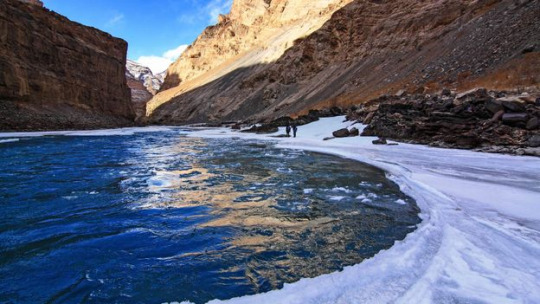
Amidst these challenges, the Chadar Trek offers moments of serenity and connection with nature that are truly unforgettable. It's a trek where you'll find solace in the silence of the frozen wilderness, broken only by the occasional creaking of the ice beneath your feet. The starlit nights in cozy caves along the riverbank provide an opportunity for introspection and awe at the vastness of the universe.
Throughout the journey, you'll be surrounded by the stark beauty of Ladakh's winter landscape. The ice formations take on surreal shapes, resembling frozen waves, icy stalactites, and crystalline curtains. As you walk through narrow canyons carved by the river, you'll feel like an explorer in an alien world, discovering hidden wonders at every turn.
A Glimpse into Local Life
The Chadar Trek is also an opportunity to connect with the indigenous Zanskari people who call this region home. These resilient locals have mastered the art of survival in this unforgiving environment. Their warmth and hospitality are a testament to the human capacity for kindness even in the harshest of conditions.
You'll have the chance to visit remote Zanskari villages and experience their way of life. You might share a cup of butter tea with a local family, hear folktales by the warmth of a traditional Bukhari (a wood-burning stove), and gain insights into the ancient traditions and customs that have sustained these communities for generations.
In Ladakh, where every corner seems like it's been touched by the divine, the Chadar Trek is an experience that stands out. It's not just a physical journey but a spiritual and cultural one too. The frozen Zanskar River is not just a frozen surface; it's a bridge that connects trekkers with the heart and soul of Ladakh.
So, if you're seeking an adventure that takes you to the edge of your limits and beyond, the Chadar Trek awaits. Just remember to be well-prepared, stay safe, and embrace the magic of Ladakh, both on and off the frozen river.
0 notes
Link
Chadar, which in the local dialect means “blanket,” alludes to the sheet of ice that covers the river. In January and February, the Chadar trek is conducted on the frozen Zanskar River.…
0 notes
Link
Planning to explore the country before turning 30? Check out this article to know more about the top places to visit in India.
0 notes
Text
Chadar Frozen River Trek: A Mesmerizing Odyssey Through the Icy Abyss

The Chadar Frozen River Trek, orchestrated by Himalayan Adventure Trips, stands as an extraordinary adventure that unfolds amidst the mystical landscapes of Ladakh. Trekking along the frozen Zanskar River, adventurers immerse themselves in a surreal world where icy terrain meets ethereal beauty.
Traversing the frozen riverbed, participants witness the unique phenomenon of the Chadar, a breathtaking sheet of ice forming on the Zanskar River. This surreal trail amidst towering cliffs, frozen waterfalls, and snow-laden landscapes creates an otherworldly experience. The trek demands more than physical endurance; it requires a mental fortitude to navigate the challenging icy paths and adapt to the harsh yet captivating terrain.
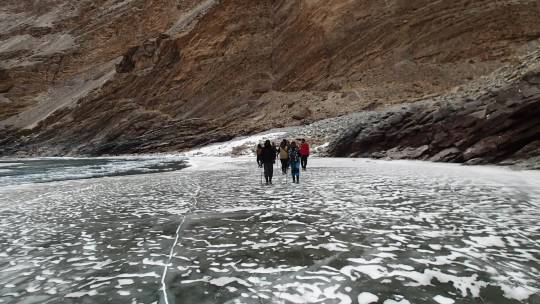
Itinerary of Chadar Frozen River Trek:
Day 1: Arrival in Leh
Arrive at Leh, the starting point of the Chadar Trek.
Acclimatization and rest to adjust to the high altitude.
Explore Leh and visit local attractions.
Day 2: Leh to Tilad Do and Shingra Koma
Drive from Leh to Chilling and then trek to Tilad Do.
Continue the trek towards Shingra Koma, walking on the frozen Zanskar River.
Camp overnight in Shingra Koma.
Day 3: Shingra Koma to Tibb Cave
Trek along the frozen river, passing through Narrows and Gorges.
Witness magnificent views of frozen waterfalls and icy cliffs.
Reach Tibb Cave and set up camp for the night.
Day 4: Tibb Cave to Naerak
Trek further to Naerak, passing through breathtaking landscapes.
Marvel at the stunning frozen cascades and unique ice formations.
Camp overnight at Naerak, near the frozen waterfall.
Day 5: Naerak to Tibb Cave
Begin the return journey, trekking back towards Tibb Cave.
Retrace the path through the gorges and icy trails.
Overnight camping at Tibb Cave.
Day 6: Tibb Cave to Shingra Koma
Trek back from Tibb Cave to Shingra Koma.
Enjoy the serenity of the frozen river and panoramic views.
Camp overnight at Shingra Koma.
Day 7: Shingra Koma to Tilad Do and Leh
Trek back to Tilad Do from Shingra Koma.
Drive back to Leh from Tilad Do.
Overnight stay in Leh.
Day 8: Rest and Explore Leh
Reserve the day for relaxation and exploration in Leh.
Visit local markets, monasteries, or indulge in cultural experiences.
Day 9: Departure from Leh
Departure from Leh, concluding the Chadar Frozen River Trek adventure.
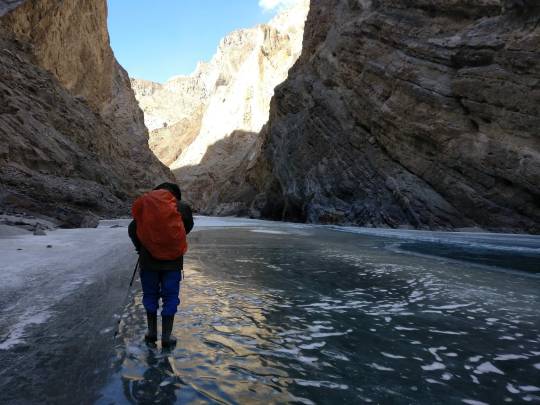
Skills Required for Chadar Frozen River Trek:
Proficiency in trekking in extreme weather conditions, walking on icy terrains, and maintaining balance.
Ability to adapt to changing weather and physical challenges encountered during the trek.
Key Points of Chadar Frozen River Trek:
Trekking along the frozen Zanskar River, experiencing the unique Chadar phenomenon.
Understanding the importance of acclimatization, safety measures, and following the guidance of experienced guides.
Highlights of Chadar Frozen River Trek:
The Chadar Frozen River Trek, a remarkable adventure amidst the stunning landscapes of Ladakh, boasts several captivating highlights that make it a unique and sought-after trekking experience:
Spectacular Natural Phenomenon:
Walking on the frozen Zanskar River, encountering the mesmerizing Chadar, a thick sheet of ice formed on the river surface during the winter months. This natural marvel creates a surreal pathway amidst the icy canyon walls.
Unparalleled Scenic Beauty:
Immersive trekking amidst breathtaking snow-covered landscapes, towering cliffs, and frozen waterfalls along the Zanskar River.
Pristine vistas of the Ladakhi Himalayas, offering panoramic views of the majestic snow-clad peaks.
Adrenaline-Pumping Adventure:
Traversing the icy terrain and challenging conditions, including walking on frozen river surfaces, navigating through icy patches, and crossing frozen water bodies, adding an element of thrill to the trek.
Cultural Encounters:
Interacting with local Zanskari residents in remote villages, providing insights into their unique lifestyle, traditions, and hospitality despite the harsh winter conditions.
Spiritual and Tranquil Ambiance:
A serene and tranquil environment enveloping trekkers as they trek through the snow-covered landscapes, creating an aura of peaceful solitude amidst nature's frozen beauty.
Unique Photography Opportunities:
Abundant opportunities for photography enthusiasts to capture the surreal landscapes, the glistening ice formations, and the raw beauty of the frozen riverbed.
Challenging Yet Rewarding Experience:
Testing physical endurance and mental fortitude while trekking through extreme cold, navigating icy trails, and adapting to the challenging weather conditions, making the trek a rewarding accomplishment.
Expert Guidance and Camaraderie:
Guided by experienced trek leaders and support staff, fostering a sense of camaraderie among fellow trekkers, sharing the challenges and triumphs of the expedition. The Chadar Frozen River Trek is a blend of natural beauty, adventure, cultural immersion, and personal achievement, offering an unforgettable journey through the frozen landscapes of Ladakh, making it a bucket-list-worthy experience for adventure enthusiasts worldwide.
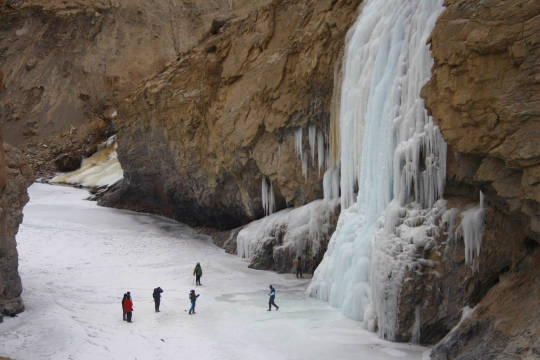
Perfect Time to Visit Chadar Frozen River Trek:
The best time to embark on the Chadar Frozen River Trek is during the winter months, particularly from January to mid-February. This period offers the ideal conditions for the formation of the iconic Chadar or blanket of ice on the Zanskar River, creating a unique and breathtaking trekking trail.
The trek is primarily undertaken during the coldest months of Ladakh's winter when the temperatures drop significantly, allowing the Zanskar River to freeze over. The frozen river forms a surreal and spectacular pathway, attracting adventure enthusiasts from around the world to experience this one-of-a-kind trekking adventure.
Key considerations for the best time to visit the Chadar Frozen River Trek include:
January to mid-February: This period is generally the peak season for the Chadar trek as it offers the most stable and fully-formed ice trail, providing an immersive experience amidst the frozen landscape.
Note: The timing for this trek largely depends on weather and local conditions. The Chadar formation may vary from year to year based on temperature fluctuations and snowfall.
It's crucial to plan the trek during this specific window to ensure the presence of a stable ice trail and to experience the awe-inspiring beauty of the frozen river at its best. Trekkers are advised to stay updated on weather forecasts and consult with experienced trek organizers like Himalayan Adventure Trips - Best trekking company in India to choose the optimal time for the Chadar Frozen River Trek.
Things Himalayan Hikers Recommend forTrek:
Adequate Clothing:
Layered clothing appropriate for extreme cold conditions, including thermal wear, fleece jackets, and insulated waterproof jackets and trousers.
Good-quality, warm socks, gloves, and headwear (hats/beanies) to protect against the biting cold.
High-Quality Trekking Gear:
Sturdy and waterproof trekking boots with excellent grip to navigate icy trails and rocky terrain.
Gaiters to prevent snow and water from entering boots.
High-quality trekking poles for better balance and support on the frozen river.
Sleeping Gear:
A well-insulated sleeping bag suitable for sub-zero temperatures to ensure a comfortable sleep during camping nights.
Hydration and Nutrition:
A hydration system (water bottles or a hydration pack) to ensure regular intake of fluids. Ensure fluids don't freeze; use insulating covers or keep them close to the body.
Energy-rich snacks, nuts, chocolates, and dry fruits to maintain energy levels during the trek.
Personal Health and Safety:
Adequate acclimatization: Spend a day or two in Leh for acclimatization before starting the trek to adjust to high altitudes.
Carry essential medications and a basic first aid kit for emergencies.
Physical Fitness and Mental Preparation:
Prior physical conditioning and endurance training to cope with the challenges of walking on icy terrains and long distances.
Mental resilience and a positive mindset to face unpredictable weather conditions and adapt to changing circumstances.
Respect for the Environment and Local Culture:
Adherence to leave-no-trace principles: Maintain cleanliness by carrying back all non-biodegradable waste.
Respect local customs and traditions of the region and follow guidance provided by local guides or Himalayan Adventure Trips.
Trekking in Groups and Following Guides:
Trek in a group, following the lead of experienced guides from the trek organizer for safety and proper navigation along the Chadar trail.
By adhering to these recommendations, trekkers can better prepare themselves for the unique challenges and beauty of the Chadar Frozen River Trek, ensuring a memorable and safe expedition through the frozen landscapes of Ladakh.
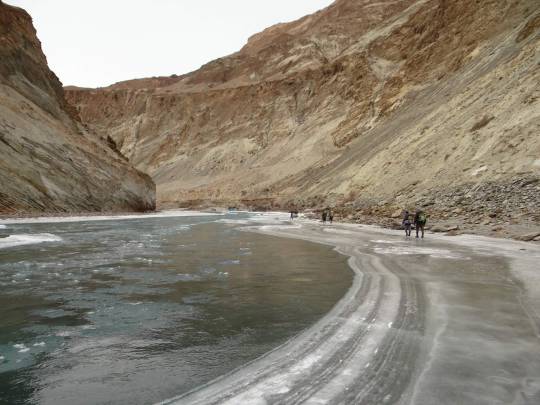
How to Reach Chadar Frozen River Trek:
Reaching the Chadar Frozen River Trek involves arriving at Leh, which serves as the starting point for this adventurous expedition. Here's how to reach Leh:
By Air:
The most common way to reach Leh is by air. The Kushok Bakula Rimpochee Airport in Leh operates regular flights from major cities like Delhi, Mumbai, and other major Indian cities.
From the airport, participants can arrange for transport to the designated meeting point for the Chadar Frozen River Trek, typically organized by the tour operator, Himalayan Adventure Trips.
By Road:
Leh is also accessible by road, primarily through two routes:
Manali-Leh Highway: A scenic but challenging road trip from Manali to Leh that usually opens in late May or early June, depending on weather conditions.
Srinagar-Leh Highway: Another picturesque road route from Srinagar to Leh that generally opens earlier than the Manali-Leh Highway.
Participants can travel by bus, taxi, or their private vehicle along these routes to reach Leh.
Upon Arrival in Leh:
Upon reaching Leh, participants are typically received by representatives from Himalayan Adventure Trips at a pre-designated location, often a hotel or guesthouse.
The tour operator organizes further logistics, including transportation to the trek's starting point and a briefing session about the Chadar Frozen River Trek.
It's essential to check the availability of flights or road conditions, especially during winter months when certain routes may be closed due to snow or adverse weather conditions. Planning and coordination with the tour operator are crucial to ensure a smooth and well-organized start to the Chadar Frozen River Trek adventure.
The Chadar Frozen River Trek is an otherworldly adventure that offers a glimpse into the serene yet harsh beauty of the Zanskar region. Himalayan Adventure Trips orchestrates this trek, providing a safe and memorable experience amidst the icy splendor of the Himalayas. As adventurers traverse the frozen river, they immerse themselves in an expedition that's not just a trek but a mesmerizing journey etched in icy trails and unforgettable memories.
The Chadar Frozen River Trek culminates as an expedition that transcends mere trekking; it becomes an unforgettable saga of exploration and resilience. Participants, upon completing this surreal odyssey, carry with them not just memories but a profound sense of accomplishment, having conquered the icy abyss amidst the grandeur of the Himalayas.
0 notes
Text
Chadar Trek 2024
Embark on an unforgettable adventure with Tempest Treks for Chadar Trek 2024. Join us for an exhilarating journey through the stunning landscapes of the Himalayas, experiencing the thrill of walking on the frozen Zanskar River. Trust our expert guides for a safe, immersive, and memorable trekking experience.
0 notes
Text
Adventure Tour 1

"The Chadar Trek: an extraordinary journey of courage, resilience, and the triumph of the human spirit."
Adventure Tour 1 : Chadar Trek -2022
Trip Duration: 08 Nights / 09 Days
Destinations Covered: Leh – Gyalpo – Tibb Cave – Naerak Camp – Leh
Read the full article
0 notes
Text
Trekking to the Zanskar Trek in North India
Everything feels easy to you! You have dived into the deep sea. You have swam with a shark, and jumped from a terrifying height onto a rough ledge. But, have you hiked to the frozen lake across a thick layer of ice? All are done and dusted! So, what will the Zanskar trek do for you?
Well, YOU ARE WRONG.
Zanskar Trek, aka the Chadar Trek, is one of the most cherished winter trails in Ladakh, India. While the frigid weather has the entire country trembling, you still have to wait for the harsh winter to hit Zanskar Gorge. The wait won't be over until the Zanskar river is frozen completely. Only then the journey will start at the altitude of 11,123 ft above the ground level. The trekking will technically take place on the frozen Zanskar river. The river in winter looks like a thick sheet of ice, hence the name Chadar.

As the name ‘Chadar” radiates comfort to your soul, the trek is anything but easy. Rather, the Zanskar trek is considered one of the most difficult yet eye-soothing experiences in life. Yet, this does not imply that the location is only approachable during the winter. Tourists can visit the place in summer as well. Therefore, if you are not in a comfortable situation to visit the place in winter, you can try summer. The river is usually streaming during the summer. As a result, tourists may enjoy river rafting while exploring Ladakh's natural beauty. And to let you know that you will be rafting on one of the world's highest, most exotic, and isolated river trips.
The river passes roughly 105 kilometres from Remala to Nimu near Leh. But, the measurement is just one way, and the journey is both exhausting and intimidating. Though the expedition is largely about walking over the ice river, there may be some cold rocks and boulders to climb along the way.
Everything will seem simple to you at this point. But, when you walk on the frozen lake, the cold will numb your foot. Consider how the cold will freeze your body. Now, you may be wondering why your body will feel cold. Answer to this.
At the end of the day, when you have completed your quest, where will you lie down? There won't be any houses, forget about hotels. The trek coordinator will arrange tents or camps right over the ice. You have to sleep in a sleeping bag over the frozen river. As the night darkens, the temperature will decrease to -32 to -35 degrees. While we don't leave our residences in temperatures of 4 to 5 degrees, strolling in -35 degrees won't be easy for everyone. That is why it is necessary to understand your body and its durability. Zanskar trek is not for all, and people need to acknowledge that.
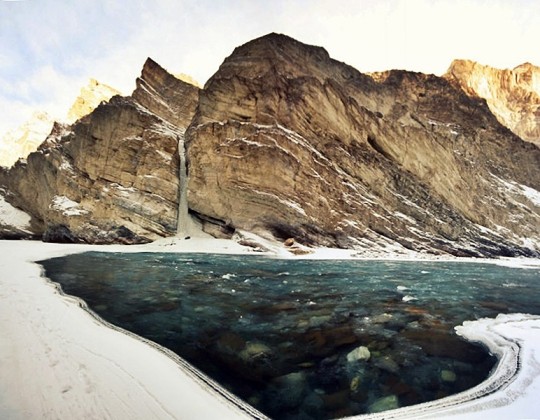
After the obstacles, one may wonder why the Zanskar trip is so popular among trekkers. The visitor shall bear the whole responsibility when trekking. You must perform everything on your own, from bringing fundamental supplies to using them all. Hence, when you complete the Zanskar quest, you will get an understanding of your capabilities. You will be aware of every element of your life. The adventurous spirit will be strong, and you will push yourself to finish the journey. After you finish the trip, a sense of relief and happiness will wash over you, making you feel brave.
The Chadar or Zanskar trip is difficult, but the reward is tranquil. On the contrary, if your soul yearns for adventure and the Zanskar expedition tickles your interest, you must embark on the journey.
1 note
·
View note
Text
Chadar Trek In Leh – over the Zanskar River range of Ladakh
Your trek journey started with Himalayan Hikers, the beautiful mountain town of Leh, all our trekkers reach Leh by flight this is the best option for your reach to Leh, altitude is 11400 feet above sea level, and the trek beautiful Zanskar River which liws totally frozen during the December to Feb, Peak Winters Trek, So, probably the best time to do Chadar Trek is February because the ice remains harsh and stable. Trek starts from the freezing point of the Zanskar River and that is Chilling.
Therefore, the “Chadar trek” is also known as “The Frozen River Trek”. This Trek is over a frozen river in the Zanskar region of Ladakh and it is different from all other treks in the Himalayas.
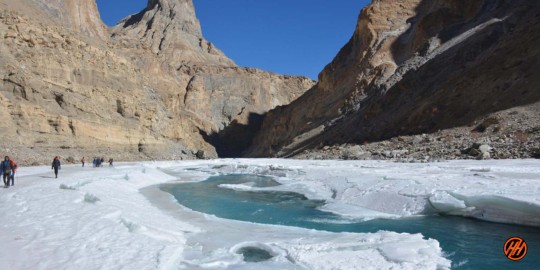
Ice Covering and Freezing Cold in Chadar Trek
The Chadar trek is over a frozen river and the ice can turn dangerous sometimes but can also be safe the other times. But, it is important to find a safe path over the perilous sheet of ice.
During the trek, you do not camp here at the meadows or the forest clearings but inside the caves which are present along the banks or you set up the tents on stable ice.

Be Aware During Chadar Trek (Not for Beginners)
You need to be very aware of the stability of ice and conditions below the feet for a safe trek. Sometimes the ice isn’t stable and the choices go wrong so walk carefully if suddenly a crack appears to go fast to the place where the ice is
So, choose a camping spot wisely after properly analyzing the area.
Here are some tips to do Chadar Trek –
Analyze the ice sheet conditions.
Avoid the cracks in the ice.
Walk carefully on slippery areas.
Run immediately to a stable area if a sudden crack appears under your feet.
Walk on the places with a coating of snow.
Choose camping spots wisely.
Alcohol and smoking are not allowed during the trek
Level- Difficult
During the trek, proper conditioning & training of the body required
Need proper gear & clothing for sub-zero temperature
Shoes are the single most important piece of equipment.
High Altitude requires proper acclimatization. Of base camp Leh
Beautiful landscapes so carry good photo gear & Extra battery backup.
Travel headlight
The backpack should not exceed 12 kg.
Long Gumboots are mandatory for all trekkers
Also Read About – Chaainsheel Bugyal Trek – The most beautiful ridge trek
About Leh – Ladakh – The Land of High Passes
Area: 98,000sq km
Altitude: 7,500m Max.
Population: 250,000
Religion: Buddhism, Islam. Hindu
Geographical Status: Cold Desert
Across the Kashmir Valley and over the famous Zoji La pass lies Ladakh, the Land of High Passes. It is a magical land, so completely different from the green landscape of some other parts of the Himalayas. It is nature at its extreme. A land of freezing winds and blazing sunlight, Ladakh is a cold desert lying in the rain shadow of the Great Himalayas and other smaller ranges. Little rain and snow reach this dry area, where the natural forces have created a fantastic landscape.
Ladakh forms part of the state of Jammu and Kashmir in India. Parts of Ladakh are under the illegal occupation of Pakistan and China. The border of Ladakh touches those of Afghanistan, Pakistan, China, the Kashmir Valley (India), and Himachal Pradesh (India). This region is made up of two administrative districts — Leh District, with its headquarters at Leh, and Kargil District, with its headquarters at Kargil –and covers a total area of about 59,000 square kilometers.
Ladakh is at an average elevation of 2,700 m to 4,200 m. The aridity of this region is due to its location in the rainshadow area of the Great Himalayas, elevation, and radiation of heat from the bare soil. The most striking physical feature of Ladakh, however, is the parallelism of its mountain ranges. The region is extremely dry, with annual rainfall as low as 10 cubic centimeters.
In Ladakh, large rivers and their tributaries have carved deep gorges far below their steep banks. However, their water is not of much use as the terraced fields lie high above the gorges.

The altitude we are going to cover in Chadar Trek
Leh – 3500 Meters
Tsomo Paldar camp – 3200 Meters
Tibb Cave camp – 3300 Meters
Nerak camp – 3400 meters
ATM Point & Mobile connectivity in Chadar Trek
ATM POINT: Hi trekker ATM available in Leh Withdraw money before your journey,
Mobile Connectivity: There will be available all networks only postpaid
Key Points of Chadar Trek
Duration: – 8 Nights 9 Days from Leh to Leh
Base camp: – Leh
Winter Temperature:- Day -5°C to -15°C) Night – 12° C to -20° C
Chadar trek – Altitude: – 11400 feet
Best Time: – Jan or Feb
Trek Level: – Difficult
Trek distance: – On foot 57 Km – By taxi 140 km
Group Size: – minimum of 5 people maximum of 15 people
Temperature
The winter temp. touches as low as minus 30 degrees (Leh & Kargil) and minus 60 degrees in (Drass) subzero temp. prevails from December to February throughout Ladakh, whereas, zero-degree temp. is experienced during the rest of the winter months. This results in the freezing of all conceivable water resources. During summers the maximum temp. increases from 20 degrees C to 38 degrees C in July and August

Languages Spoken
Ladakhi is the main language of Ladakh. Other languages spoken are Balti, Shina, Brokshat, and Changsha. In hotels and restaurants, staffs speak English and Hindi, while tour guides are well-versed in the language.
Key Points about Chadar Trek
– Level: Difficult (so first-timers trekkers should avoid)
– Proper conditioning & training of the body required
– Group size minimum of 05 and a maximum of 15 people
– Need proper Expedition gear & clothing for sub-zero temperatures?
– Shoes are the single most important equipment
– High Altitude requires proper acclimatization
– Phones don’t work on the trek, we provide to you Radio Walkie Talkie for Communication
– Beautiful landscape so carry good photo gear (I couldn’t carry my best equipment)
– Travel light (my backpack was heavy at about 12 kg to 15 Kg )
– Keep an extra day in your itinerary for attempt to Chadar trek summit account for bad weather
– Alcohol and smoking is not allowed in during the Chadar Trek Expedition
Difficulty level
Because the top is relatively high in elevation, we strongly recommend a reasonable level of physical fitness. The arduous journey of Chadar trek winter hiking with longer distances and ascending elevations to be covered in a short span of time would require acclimatization. We advise trekkers to physically and mentally prepare themselves prior to this trek. Throughout the course, all groups will be guided by our experts for trekking equipment and any impending terrain.
Any medical assistance that is required will be provided at any point of the journey; however, trekkers must consult their professional care before beginning any trek. We also strongly advise trekkers to learn about altitude sickness and to notify our teams as soon as any symptoms appear.
Short Itinerary of Chadar Trek
Day 1:- Arrival at Leh – pickup to you from Airport drive to Hotel check in Rest and Acclimatization overnight stay Hotel
Day 2:- Trek Planning and Briefing – Acclimatization and Preparation- meet us our Himalayan Hikers Guide overnight stay
Day 3:- Medical Test Day in Leh
Day 4:- Drive from Leh to Bakula (70 km) (2 hours) same Day Trek Bakula to Shingra Koma 2/3 Hours overnight stay Camp
Day 5:- Trek from Shingra Koma to Tibba (16 km) (6/7 Hours) overnight stay Camp
Day 6:- Trek from Tibba to Nerak Waterfall (12 km )( 6/7 Hours) overnight stay Camp
Day 7:- Trek from Nerak to Tibba (16km ) (6/7 hours) overnight stay Camp
Day 8:- Trek from Tibba to Bakula (12 km) (6/7 hours) Same day Drive to Leh Hotel
Day 9:- After breakfast Depart from Leh
Permit and Passport
Tourist don’t require permit for Leh, however, all foreigners are required to be registered at Drass, Rumtse and Serchu if they are travelling overland. Those traveling by air get themselves registered at airport. Tourists are required to get permit for restricted areas like Tsomoriri, Tsokar and Pangong Lakes, Dhahanu and Nubra Valley, which can be obtained from District Magistrate, Leh, through Travel Agents at Leh.
Avoid acute mountain sickness
Acute mountain sickness can occur to any one at an altitude above 10,000 ft. above sea level, therefore, make it sure to take complete rest on the day of arrival.
How to Reach Leh or ladakh
Overland Approach
Overland Approach – The overland approach to Ladakh from Kashmir Valley via Kargil is approx. 434 Km, which remains open for traffic from early June to November. The most dramatic part of this road journey is the ascent up the 11,500 feet / 3,505 m high Zoji-La, the pass in the Great Himalayan Wall that serves as the gateway to Ladakh. The J & K State Road Transport Corporation (J&K SRTC) operates regular Deluxe and Ordinary bus services between Srinagar and Leh on this route with an overnight halt at Kargil. Taxis (cars and jeeps) are also available at Srinagar for the journey. Groups can charter Deluxe and A-class buses for Leh, Kargil or Padum (Zangskar) from the J & K SRTC at Srinagar.
Manali to Leh – Since 1989, the 473 km. Manali-Leh road has been serving as the second overland approach to Ladakh. Open for traffic from around mid-June to early October. This high road traverses the upland desert plateau of Rupsho, altitude ranges from 3,660m to 4,570m. A number of high passes fall enroute among which the highest one known as Taklang-La is world’s second highest motorable pass at an altitude of 17,469 feet/5,235m. Himachal Pradesh Tourism, HRTC and J & K SRTC operate daily Deluxe and Ordinary bus services between Manali and Leh. The bus journey between Leh and Manali takes about 19 hours or two days with an overnight halt in camps at Serchu or Pang. Shared taxis are also available both from Leh and Manali
Road Distances
Srinagar-Leh 434 Km
Manali-Leh 473 Km
Srinagar-Kargil 204 Km
Delhi-Leh 1047 Kms
Leh-Kargil 234 Km
Kargil-Padum (Zanskar) 240 Km
Leh-Deskit (Nubra Valley)118 Kms.
Credit Cards & ATM Machine
Credit cards are accepted by very few hotels and tour operators but there will be 2.5% service charge. The Jammu and Kashmir Bank and State Bank of India has placed ATM Machine in Leh. The State Bank of India accepts visa and mastero but this ATM is not very reliable. J&K Bank ATM is more reliable but accepts only Mastero.
Air Travel
Indian Airlines http://www.indian-airlines.nic.in operates regular flights to Leh from Delhi (fare USD 135), Four flights in a week from Jammu and once in a week from Chandigarh and twice from Srinagar. Jet Airways http://www.jetairways.com also operates daily flights between Leh-Delhi (fare USD 143).
Internal Transport
The cheapest way to travel within the region is by public buses, which ply on fixed routes according to fixed time schedules. The most comfortable and convenient though expensive mode of travel, however, is by taxi, which are available for hire on fixed point-to-point tariff. For visits to the newly opened areas of Nubra, Dah-Hanu, Tsomoriri, Tsokar and Pangong Lakes. It is mandatory to engage the services of a registered/recognized travel agency for making all the requisite arrangements including internal transport. Detailed information about bus schedules, taxi tariff, travel agencies can be obtained from the Tourist Office or Local travels guide “Reach Ladakh”, available at Book Shops.
Leh is the headquarter of Leh District, and the largest town of the region. It is located to the north of the Indus River at an elevation of 3600m above the sea level. The town is dominated by the nine-storey Namgyal Palace and Namgyal Tsemo (victory peak), built by Tashi Namgyal on his victorious in reunification of the Upper and Lower Ladakh. Leh became the capital of Stod (upper Ladakh) during the reign of king Graspa Bum- Lde,who ruled Ladakh from 1400 to 1430 AD. In the later period, Leh became an important center for trade in Central Asia. Leh remained merely a headquarter of Ladakh district until 1974, when Ladakh was opened for foreign tourists. Since then period Leh became the centre for tourism related activities in the region.
Fact File
Leh provides medium and lower class accommodation, with hundreds of guesthouses and hotels, which can suite every budget. Restaurants offer good multicuisine for a reasonable price. There are number of tour Operator/Travel Agents around the town, which look after traveler’s requirements.
Tour of Buddhist monasteries can be organised in one or two days, as all the famous monasteries are within a drive of one or two days from Leh. For information on monasteries please check monastery section of this web site.
0 notes
Text
اونٹ 🐫 سے محبت
ہم اعوان عربی النسل لوگ ہیں۔۔ بھیڑوں 🐑 ، بکریوں 🐐 اور اونٹوں 🐫 سے محبت ہمارے خون میں شامل ہے۔
آج جابہ وادی سون میں دربار پر چادر پوشی کا سالانہ تہوار ڈالی منایا گیا جسمیں گاؤں بھر کے اونٹ رکھنے والوں نے اپنے اونٹ سجا کر شرکت کی۔۔
مزید تصاویر اور تفصیلات جلد شیئر کروں گا ۔
احسان اعوان
Love the camel 🐫
We are Awan from Arab tribe. Love for sheep 🐑, goats 🐐 and camels 🐫 is in our blood.
Today, the annual festival of chadar poshi was celebrated at Darbar in Jaba Wadi Soon. Camel owners from all over the village participated by decorating their camels.
Will share more pictures and details soon.
Ehsan Awan
#camels #soonvalley #awan #tribe
#SVT
#Waterfall #Nature #Forest #Travel
#Soonvalley #sustainabletourism #Culture #Photography #Archaeology #Trip #ecotourism #Wild #Beauty #Pakistan #Adventure #Tours #Camping #Mountains #World
#Hiking #Trekking #Biodiversity #Organic #Travelblogger
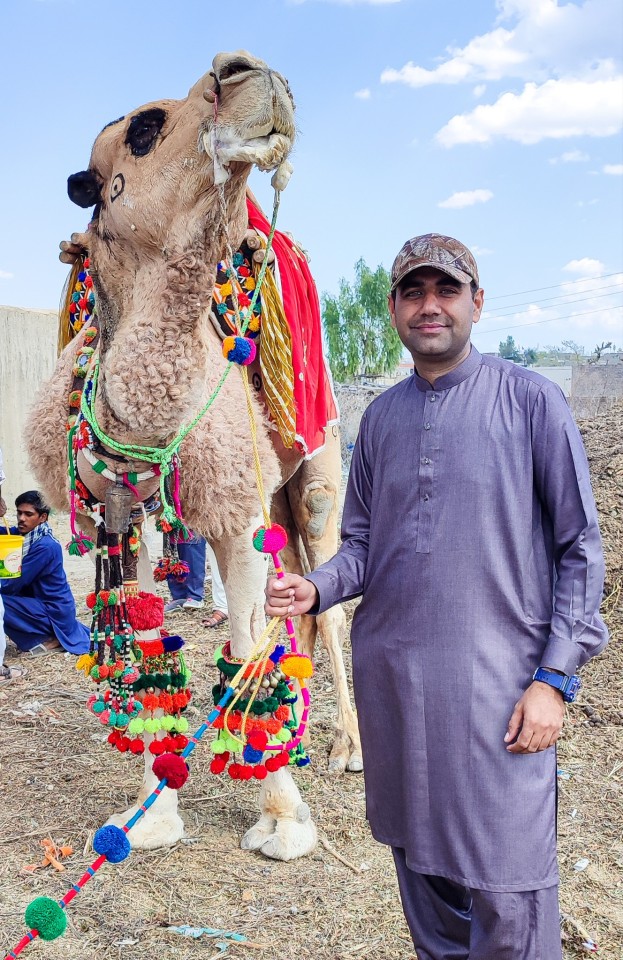
6 notes
·
View notes
Text
Best Time to Book a Ladakh Package Tour: Seasonal Insights

Planning a trip to Ladakh, the mesmerizing land of high passes and breathtaking landscapes, is an adventure in itself. The timing of your Ladakh package tour can greatly influence your experience due to the region's distinct seasonal changes. Whether you're interested in exploring the vibrant monasteries, witnessing the stunning Pangong Lake, or embarking on an offbeat adventure through Leh Ladakh, understanding the best time to visit is crucial. Let's delve into the seasonal insights to help you decide when to book your Ladakh tour package.
Understanding Ladakh's Seasons
Ladakh experiences two primary seasons - summer and winter - each offering unique charms and challenges. The best time to visit depends on your preferences, whether you prefer warmer temperatures and accessibility or are drawn to the region's serene winter wonderland.
Summer (May to September)
Summer is the peak tourist season in Ladakh when the weather is most favorable for travel and exploration. The months from May to September witnessed a surge in Ladakh tour packages due to the clear skies, moderate temperatures, and accessibility of roads and passes.
During this time, Leh Ladakh tour packages are popular, allowing visitors to explore the stunning monasteries like Hemis, Thiksey, and Diskit. The Pangong Lake, a highlight of many Ladakh tour packages, is accessible via road and displays its mesmerizing shades of blue under the clear summer skies. Adventurers can also opt for thrilling activities like river rafting in the Zanskar River or trekking in the picturesque Markha Valley.
The summer months also coincide with various cultural festivals in Ladakh, such as the Hemis Festival in June and the Ladakh Festival in September, offering visitors a chance to experience the region's rich heritage and traditions.
Monsoon (July to August)
While Ladakh generally experiences very little rainfall, July and August see sporadic showers. The monsoon season, though short-lived, can impact travel plans due to roadblocks caused by landslides. However, this period also transforms Ladakh's arid landscapes into lush green patches, presenting a unique and lesser-seen side of the region.
Autumn (September to October)
Late September to October marks the onset of autumn in Ladakh. This shoulder season is characterized by clear skies, pleasant daytime temperatures, and fewer tourists compared to peak summer months. It's an excellent time for those looking to explore Ladakh in a quieter setting while still enjoying favorable weather conditions.
Winter (November to April)
Winter in Ladakh is a stark contrast to its bustling summer counterpart. The region gets blanketed in snow, and most high-altitude passes become inaccessible due to heavy snowfall. However, winter is gaining popularity among adventurers seeking unique experiences. Pangong Lake, frozen solid during this time, offers a surreal landscape for photography enthusiasts.
Leh Ladakh offbeat tour packages are ideal for winter exploration, focusing on experiences like Chadar Trek (walking on the frozen Zanskar River), wildlife spotting in Hemis National Park, and witnessing the traditional Ladakhi life against the backdrop of snow-clad mountains.
Choosing the Best Time for Your Ladakh Tour Package
To make the most of your Ladakh package tour, consider the following factors when deciding the timing:
Weather Preferences: Determine whether you prefer moderate temperatures and accessibility (summer) or snowy landscapes and unique winter experiences (winter).
Activity Interest: Identify the activities you wish to undertake, such as trekking, monastery visits, or experiencing cultural festivals.
Crowd Avoidance: If you prefer quieter surroundings and fewer tourists, consider visiting during the shoulder seasons of late spring (May) or autumn (September to October).
Budget Considerations: Peak tourist season (summer) usually means higher prices for accommodations and tour packages. Shoulder or off-season visits can be more budget-friendly.
The best time to book a Ladakh package tour ultimately depends on your travel preferences and interests. Whether you're captivated by Ladakh's vibrant summer landscapes or intrigued by its serene winter charm, planning your trip around the seasonal insights will ensure a memorable experience. Be it exploring the Pangong Lake, discovering ancient monasteries, or embarking on an offbeat adventure through Leh Ladakh Pangokg Lake Package Tour, Ladakh promises an unforgettable journey regardless of the season. So, pack your bags and get ready to explore the mesmerizing beauty of Ladakh at the perfect time for you.
Book the 2024 Season Spl Ladakh Package Tour with NatureWings Holiday Ltd. and explore the magical beauty of Paradise.
You can talk 24*7 to our Ladakh Trip Super Specialist Ms Sayoni +91-97485-90505
For More Details Visit Our Ladakh Tour Package URL :
Package Name: Amazing Leh Ladakh Package Tour
Ladakh Tour Duration: 8 Nights / 9 Days
Destinations Covered : Leh 5N | Kargil 1N | Nubra Valley 1N | Pangong Lake 1N
Pickup & Drop: Kushok Bakula Rimpochee Airport [IXL], Leh, Ladakh, India
DAY WISE PANGONG LAKE TOUR PACKAGE ITINERARY
DAY 1 → AIRPORT TO LEH HOTEL
DAY 2 → LEH LOCAL SIGHTSEEING
DAY 3 → LEH TO KARGIL VIA MAGNETIC HILL
DAY 4 → KARGIL TO LEH ENROUTE LAMAYURU MONASTERY
DAY 5 → LEH TO NUBRA VALLEY VIA KHARDUNGLA PASS
DAY 6 → NUBRA TO LEH ENROUTE DISKIT MONASTERY
DAY 7 → LEH TO PANGONG LAKE VIA CHANGLA PASS
DAY 8 → PANGONG LAKE TO LEH VIA HEMIS MONASTERY
DAY 9 → DEPARTURE FROM LEH
LADAKH PACKAGE TOUR INCLUSIONS :
Accommodation in listed Hotels
Breakfast and Dinner only
Transfers and all sightseeing in an exclusive Private vehicle
Parking, Toll Tax, Permits
Guest Service Support during trip from India office 24/7
LADAKH TOUR PACKAGE EXCLUSIONS :
Any item which is not mentioned in the Inclusion section
Lunch or any other meal
All Museums, Monuments and other entry Fees
Parking, Toll Tax, Permits
Laundry, Tips, Phone Call or any Personal Expenses
For More Details About the Leh Ladakh Package Tour Visit Our Official Address:
NatureWings Holidays Limited
DGK – 417, DLF Galleria, Newtown
Kolkata, West Bengal 700156
Ph: 098300 13505
Website: https://www.naturewings.com/
0 notes
Text
Zanskar Chadar Trek | Zanskarfeels.com
Experience the majestic beauty of the Zanskar Chadar Trek with Zanskarfeels.com. Our passionate guides will make sure you have the most memorable and emotional journey of your life!
zanskar chadar trek
0 notes
Link
Explore the blog to know more about Chadar Trek Ladakh, Cost, Frozen River Trek, Chadar Frozen River Trek and more.
0 notes
Link
Planning to explore the country before turning 30? Check out this article to know more about the top places to visit in India.
0 notes
Text
The Chadar Trek 2023 will be an even more challenging and exciting trek, as it will be the first time the trek is being organized in winter. https://bit.ly/3TR41ap
#chadar trek 2023#chadar trek booking#chadar frozen river trek#frozen river chadar trek#chadar trek package#chadar trek cost#chadar trek price
0 notes
Text
Unlocking Leh Ladakh: A Journey Through Timeless Landscapes
Nestled amidst the majestic Himalayas, Leh Ladakh stands as a testament to nature’s grandeur and human resilience. With its awe-inspiring landscapes, rich cultural heritage, and adventurous spirit, this remote region in northern India beckons travelers seeking an escape into the heart of untouched beauty. From serene monasteries perched on rocky cliffs to pristine lakes reflecting the azure sky, there are many things to do in Leh Ladakh and it offers an unforgettable experience for those willing to embark on a journey off the beaten path through its amazing places to visit.

Exploring Leh: A Glimpse into Ancient Traditions
Leh Palace: Rising like a silent sentinel above the town of Leh, the Leh Palace transports visitors back in time to the era of Ladakh’s royal heritage. Built in the 17th century by King Sengge Namgyal, this nine-story palace boasts stunning panoramic views of the surrounding landscape, making it a must-visit for history enthusiasts and photography aficionados alike.
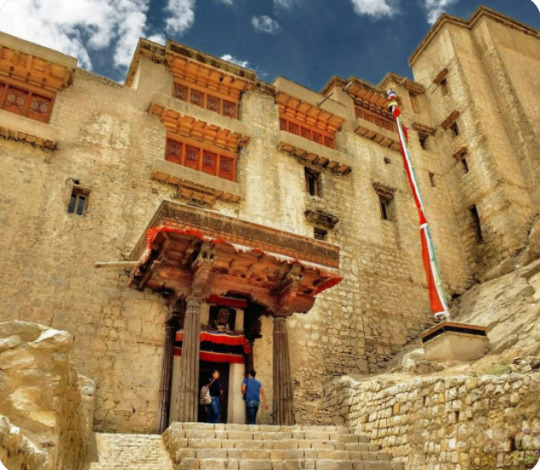
Shanti Stupa: Perched atop a hill overlooking Leh, the Shanti Stupa is a symbol of peace and harmony. Built by Japanese monks to commemorate 2500 years of Buddhism, this gleaming white stupa offers a tranquil retreat where visitors can meditate and soak in the serene atmosphere while enjoying breathtaking vistas of the town below.

Leh Market: Immerse yourself in the vibrant tapestry of Ladakhi culture at the bustling Leh Market. From intricately woven textiles to traditional handicrafts, this lively bazaar offers a treasure trove of souvenirs and keepsakes to commemorate your journey through the Himalayan highlands.

Embracing Nature’s Splendor: Must-See Natural Wonders
Pangong Lake: Prepare to be mesmerized by the ethereal beauty of Pangong Lake, whose shimmering turquoise waters stretch as far as the eye can see. Located at an altitude of over 14,000 feet, this iconic lake is best known for its ever-changing hues and dramatic mountain backdrop, making it a favorite destination for photographers and nature enthusiasts.
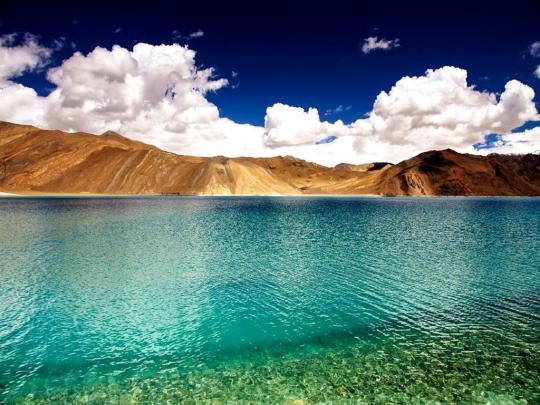
Nubra Valley: Embark on an unforgettable adventure to the enchanting Nubra Valley, a hidden oasis nestled amidst towering sand dunes and snow-capped peaks. Traverse the world’s highest motorable pass, Khardung La, and descend into this picturesque valley dotted with quaint villages, lush orchards, and the mystical Diskit Monastery, home to a towering statue of Maitreya Buddha.

Tso Moriri: Escape the crowds and immerse yourself in the pristine wilderness of Tso Moriri, a high-altitude lake located in the remote Changthang region of Ladakh. Surrounded by rugged mountains and vast grasslands, this serene lake is a haven for birdwatchers and wildlife enthusiasts, offering a rare glimpse of the elusive Tibetan wild ass and other native species.
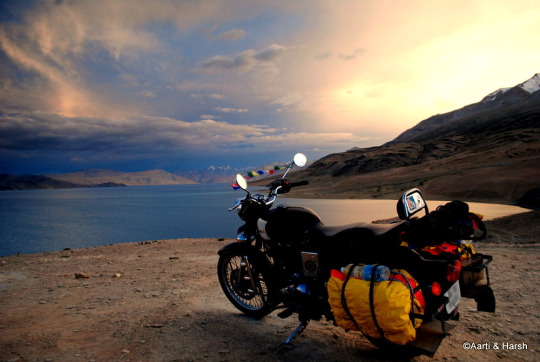
Adventure Awaits: Thrilling Activities for the Brave at Heart
Trekking: Lace up your hiking boots and embark on an epic trek through Ladakh’s rugged terrain. Whether you’re a seasoned mountaineer or a novice adventurer, there are trails to suit every skill level, from the classic Markha Valley trek to the challenging Stok Kangri summit expedition.

White Water Rafting: Feel the adrenaline rush as you navigate the frothy rapids of the mighty Zanskar River on a white water rafting expedition. With its pristine waters and breathtaking scenery, Ladakh offers some of the most exhilarating rafting experiences in the world, including the famous Zanskar River Chadar Trek during the winter months.
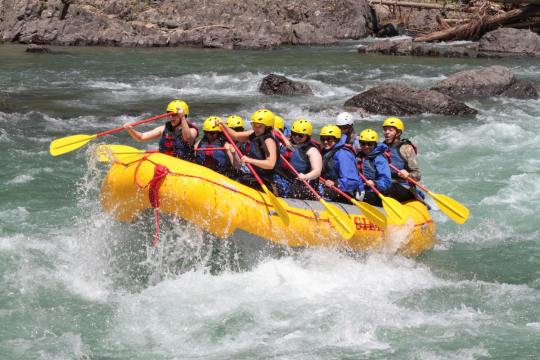
Motorcycle Tours: Channel your inner explorer and hit the open road on a thrilling motorcycle tour through the rugged landscapes of Ladakh. With its winding mountain passes, steep gorges, and stunning vistas, the region offers an unparalleled adventure for riders seeking the ultimate freedom of the open highway.
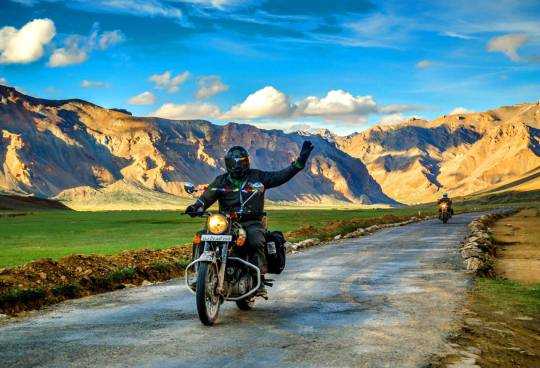
Immersing in Spiritual Serenity: Monasteries and Meditation Retreats
Thiksey Monastery: Perched on a hilltop overlooking the Indus Valley, the Thiksey Monastery is a sprawling complex of whitewashed buildings adorned with colorful murals and prayer flags. Explore its labyrinthine corridors, visit the ancient temples and meditation halls, and witness the monks’ daily rituals as they chant prayers and perform sacred ceremonies.

Hemis Monastery: Delve into the mystical realm of Tibetan Buddhism at Hemis Monastery, one of the largest and wealthiest monasteries in Ladakh. Founded in the 17th century, this ancient monastery is famous for its annual Hemis Festival, where monks perform sacred masked dances to commemorate the birth anniversary of Guru Padmasambhava.

Meditation Retreats: Unplug from the distractions of modern life and embark on a journey of self-discovery at one of Ladakh’s many meditation retreats. Whether you’re a seasoned practitioner or a curious beginner, these tranquil sanctuaries offer the perfect opportunity to rejuvenate your mind, body, and spirit amidst the pristine beauty of the Himalayas.
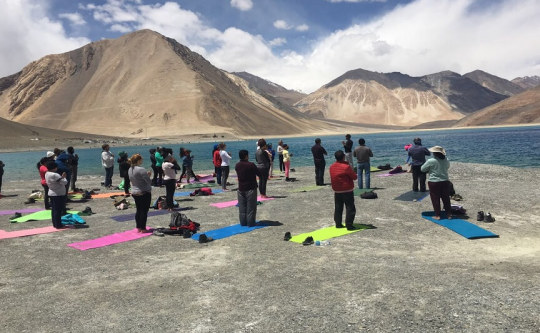
Practical Tips for Travelers:
Altitude Acclimatization: Due to its high altitude, Leh Ladakh presents a risk of altitude sickness for unprepared travelers. It’s essential to acclimatize gradually by spending a few days in Leh before venturing into higher altitudes.
Pack Wisely: Be sure to pack appropriate clothing for the unpredictable weather conditions in Ladakh, including warm layers, sturdy hiking boots, and plenty of sunscreen and hydration.
Respect Local Customs: When visiting monasteries and other religious sites, remember to dress modestly and observe the customs and traditions of the local community.
Stay Hydrated: The dry mountain air can lead to dehydration, so be sure to drink plenty of water throughout your stay in Ladakh to stay hydrated and healthy.

In conclusion, Leh Ladakh offers a truly immersive and transformative travel experience for adventurers, nature lovers, and spiritual seekers alike. With its breathtaking landscapes, rich cultural heritage, and boundless opportunities for exploration and adventure, this remote corner of the world beckons intrepid travelers to unlock its mystique and discover the magic of the Himalayas.
0 notes